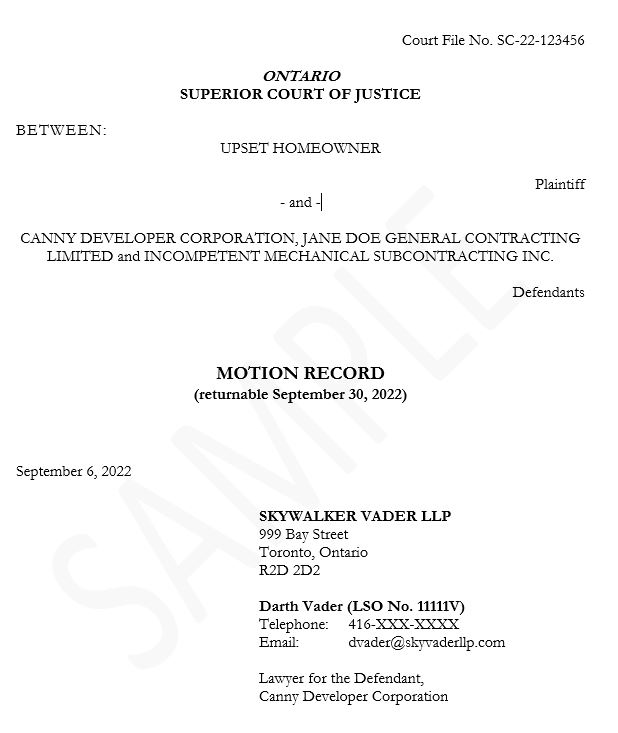Imagine this scenario: a busy architect is out making a site visit when it happens: their phone buzzes and an email pops up from a colleague alerting them that legal documents were served on the firm at reception.
When the architect opens the attached pdf, they see a bunch of legal documents, possibly under a cover letter, with the first page being entitled “Motion Record” or “Notice of Motion”.
If the architect is (fortunately) inexperienced with litigation, they may believe that they have been sued – but they were not. Even if savvy enough to know that this is something else, they may not know what to do.
Pro-Demnity has been seeing more of these motions in recent months.
What is a 30.10 Motion?
A 30.10 motion refers to a motion seeking the production of documents needed for a lawsuit from an individual, business or other organization that is not involved in that lawsuit.
There are several types of lawsuits where an architect’s file(s) might be crucial to determining key issues in dispute by other parties, even where an architect has not been sued. This could include cases where a project owner has sued a contractor, a contractor has sued a subcontractor, another consultant has sued the project owner, an end user has sued the owner, or vice versa for any of these scenarios.
The authority to seek this relief from a Court is derived from Rule 30.10 of Ontario’s Rules of Civil Procedure, which is the regulation that guides how civil litigation is conducted (think of the Rules as the Ontario Building Code of lawsuits), hence its name as the 30.10 motion.
Here is a sample below:

If you receive one, contact Pro-Demnity and your legal counsel.
What to do when served with a 30.10 Motion?
Just because an architect is not yet part of a lawsuit, this does not mean that someone who is party to it might not try to bring them in later, possibly after reviewing your file documents. This means that you should report a 30.10 motion to Pro-Demnity as a potential claim. The motion may be an innocent attempt to obtain documents that will come to nothing, but Pro-Demnity’s team are in the best situation to determine this. If there is a substantial risk that the architect could get drawn into the lawsuit, we may appoint a lawyer to represent you at the motion.
In many cases, a 30.10 motion is harmless, or unlikely (in Pro-Demnity’s view) to lead to you being involved in a lawsuit. However, even if the 30.10 motion is “harmless” from this perspective, you or a representative are still legally required to attend court on the date and at the location indicated in the Notice of Motion.
In such a case there is no coverage for Pro-Demnity to appoint a lawyer to act as your defence counsel. Large firms may have an in-house lawyer, or a go-to private lawyer who can deal with the lawyer bringing the motion and/or attend the motion on their behalf. If not, you may wish to consider retaining one of the lawyers included on Pro-Demnity’s Risk Services’ list of lawyers resources.
What will be the result of the motion?
The outcome of the 30.10 motion in nearly all cases will be to order you to provide copies of your file documents to the party seeking them. However, if you or a lawyer attend the motion, this could still be helpful in the following ways:
- Limiting the extent of the documents to be provided;
- Extending the time you have to provide the documents; and
- Securing a requirement that the party seeking an architect’s documents pay a reasonable fee for your time in administering the document transfer.
5 points to take away:
- Being served with a Motion Record for a 30.10 Motion is not a lawsuit brought against you but a request for documents to be given to someone who is involved in a lawsuit.
- Do not ignore or put off dealing with a 30.10 Motion – there are tight timelines.
- Notify Pro-Demnity of a potential claim if served with a 30.10 Motion.
- You or a representative must respond to the motion or bad things can happen (in the extreme case, you could be found in contempt of court, a criminal offence).
- You should expect the court to require you to provide documents, but you can influence when and how.
As your professional, protective ally, Pro-Demnity always has your back and will proactively defend you against allegations of errors, omissions, or negligence. If you have any questions about potential claims, speak with our Risk Services team at 416-386-1770 ext. 2, or if you receive a 30.10 motion, contact claims@prodemnity.com.
Our Contributor

Philip is an experienced litigator with a practice dedicated to defending architects against professional liability lawsuits as in-house Senior Legal Counsel at Pro-Demnity Insurance Company, which he joined in 2020. He has successfully represented clients at all levels of Court in Ontario, as well as at mediations, arbitrations, administrative tribunals and professional colleges. Philip was called to the bar in 2012 after graduating from Queen’s University Law School in 2011. Further, he completed an internship at the Khmer Rouge Tribunal in Cambodia. He is a member in good standing of the Law Society of Ontario, the Ontario Bar Association and Canadian Defence Lawyers. Recognized for his litigation expertise, Philip has contributed articles and been asked to present to insurance professionals, professional associations, and to fellow lawyers.

